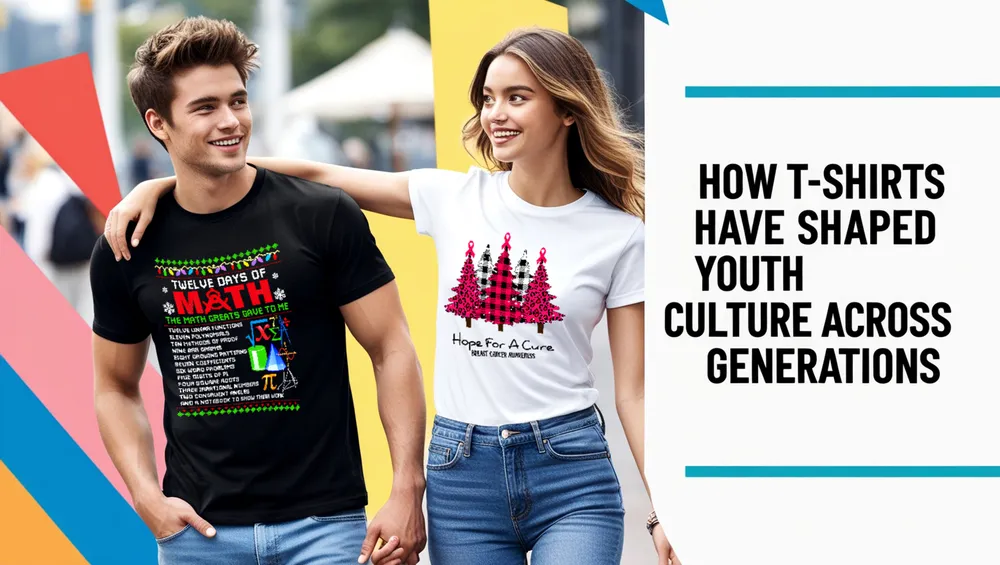No products in the cart.
T-Shirt Knowledge and Trends
How T-Shirts Have Shaped Youth Culture Across Generations
T-shirts have long transcended their role as mere clothing items; they serve as powerful cultural symbols that reflect the values, beliefs, and identities of youth across generations. From their humble beginnings as undergarments to their current status as fashion statements and canvases for social expression, T-shirts encapsulate the evolving landscape of youth culture. This article explores how T-shirts have shaped youth culture, showcasing their evolution and highlighting their significance as tools for personal expression and societal change.
The Evolution of the T-Shirt
Origins of the T-Shirt
The T-shirt has its roots in the early 20th century as a practical piece of clothing for laborers. Originally designed as undergarments for the military, they gained popularity during World War I when soldiers found them comfortable and easy to wear under their uniforms. Post-war, T-shirts began to be worn as standalone garments, particularly in the United States.
The simple design of the T-shirt—usually made from cotton and featuring a crew neckline—made it comfortable and easy to produce. This practicality allowed it to become a wardrobe staple for men, women, and children alike. By the 1950s, with icons like Marlon Brando and James Dean wearing T-shirts in films, the garment started to signify rebellion and a casual, youthful spirit.
The 1960s and the Rise of Counterculture
During the 1960s, T-shirts became synonymous with counterculture movements. Designs featuring political slogans, peace signs, and psychedelic art turned them into canvases for protest and self-expression. This era marked the beginning of the T-shirt as a medium for communicating personal beliefs, as youth began to wear T-shirts that reflected their ideals and aspirations.
With the Vietnam War escalating, many young Americans turned to T-shirts as a way to voice their dissent. For example, slogans like “Make Love, Not War” became emblematic of the peace movement. The T-shirt transformed from a simple clothing item into a statement of identity and purpose, reflecting the growing desire among youth to challenge societal norms.
Moreover, the vibrant artwork associated with this era, inspired by the psychedelic movement, allowed T-shirts to become more than just clothing; they were pieces of art. Artists like Andy Warhol began to influence the design of T-shirts, further embedding them in popular culture.
The Role of T-Shirts in Youth Identity
T-Shirts as a Canvas for Self-Expression
T-shirts enable young people to communicate their beliefs, interests, and affiliations. Whether it’s showcasing favorite bands, sports teams, or social movements, T-shirts serve as a medium for personal expression. For instance, wearing a T-shirt with a graphic of a favorite musician can signify not only a love for their music but also an alignment with the culture surrounding that artist.
T-shirts have also become popular items for youth attending concerts and music festivals. Fans often wear shirts featuring their favorite bands or artists, creating a sense of belonging and community. The T-shirt acts as a badge of loyalty, connecting fans to one another and solidifying their identities within a particular subculture.
In today’s digital age, T-shirts are more accessible than ever. Many online platforms allow users to create custom designs that reflect their unique personalities. At Capital T-Shirt, you can explore a wide variety of options that cater to diverse tastes and occasions. This trend allows youth to wear their individuality and make a statement about who they are.
Social Media and the T-Shirt Phenomenon
In the digital age, social media has amplified the influence of T-shirts on youth culture. Platforms like Instagram, TikTok, and Pinterest have turned T-shirt designs into viral sensations, making them accessible to a global audience. Many influencers use their platforms to showcase their favorite T-shirts, often promoting brands that resonate with their followers.
The hashtag culture surrounding T-shirts allows users to discover new trends and connect with like-minded individuals. Hashtags like #TshirtDesign or #GraphicTees can lead to a plethora of creative ideas, inspiring young people to express themselves through their clothing choices. The visual nature of platforms like Instagram means that a striking T-shirt design can quickly gain popularity, influencing what young people want to wear.
Furthermore, T-shirt challenges and campaigns often go viral, encouraging users to wear specific designs for causes or movements. These campaigns leverage the power of social media to spread awareness and mobilize support, showcasing the T-shirt’s role as a tool for activism and change.
The Impact of T-Shirts on Societal Trends
T-Shirts and Activism
T-shirts have become tools for social change, particularly in recent years. Movements like Black Lives Matter have utilized T-shirts to spread awareness and foster community solidarity. Wearing a T-shirt emblazoned with a powerful message can be a bold statement in support of social justice, allowing individuals to advocate for causes they believe in.
This trend towards activism has also influenced how brands create and market their products. Many companies now produce T-shirts specifically designed to raise awareness for various social issues, with proceeds going to related charities. By wearing these T-shirts, individuals can feel empowered, knowing they are contributing to a larger cause. For more information about social movements, you can visit Wikipedia’s Social Movement page.
For example, during the Women’s March, countless individuals wore T-shirts with messages of empowerment, further reinforcing the idea that clothing can be a medium for protest. T-shirts featuring slogans like “The Future is Female” or “Nevertheless, She Persisted” became symbols of the fight for gender equality, showcasing how fashion intersects with social movements.
For stylish options that celebrate fathers, check out our Father’s Day T-Shirts collection.
Fashion Trends and T-Shirts
The T-shirt’s adaptability has allowed it to fit into various fashion trends. Designers often incorporate T-shirts into high-fashion collections, demonstrating their versatility. From casual wear to upscale outfits, T-shirts remain a staple in fashion.
For instance, T-shirts can be dressed up with blazers and accessories for a chic look or worn casually with jeans for a relaxed vibe. This flexibility makes them a favorite choice for fashion enthusiasts of all ages. Explore our Christmas Shirts collection for stylish options that fit any occasion.
Fashion designers like Gucci and Balenciaga have embraced the T-shirt, incorporating them into runway shows and upscale collections. The trend of luxury brands using T-shirts has blurred the lines between casual and high fashion, illustrating how the garment can be reimagined in different contexts.
The Global Appeal of T-Shirts
T-Shirts in Different Cultures
T-shirts are not just a phenomenon in the United States; they have a global appeal that transcends cultural boundaries. Different countries have adopted the T-shirt, infusing it with local meanings and styles. For example, in Japan, graphic T-shirts often feature anime and manga characters, reflecting the country’s rich pop culture.
In other parts of the world, T-shirts serve as tools for national pride, often featuring flags, national symbols, or slogans that resonate with local sentiments. During major sporting events like the FIFA World Cup or the Olympics, fans often wear T-shirts representing their countries, creating a sense of unity and national pride.
Additionally, T-shirts are frequently used in tourism, with many travelers purchasing them as souvenirs from different destinations. A T-shirt with a city’s name or iconic landmark serves as a personal memento, allowing individuals to carry a piece of their travels with them. This has led to a thriving market for tourist-themed T-shirts, which often showcase local art and culture.
Sustainability and the Future of T-Shirts
As the fashion industry grapples with sustainability issues, T-shirts are also evolving to meet consumer demands for eco-friendly options. Many brands are now producing T-shirts made from organic cotton or recycled materials, appealing to environmentally conscious consumers.
The shift towards sustainable fashion is not just a trend; it’s a necessity for the future. Young people today are more aware of the environmental impact of their clothing choices, and they are actively seeking out brands that align with their values. This shift is transforming how T-shirts are made and marketed, ensuring their relevance in the years to come.
In response to these demands, many companies are adopting sustainable practices, such as using water-based inks for printing and offering recycling programs for old T-shirts. Consumers are increasingly prioritizing sustainability, pushing brands to be more transparent about their production processes. Explore our Outdoor Collection for eco-friendly options.
Conclusion
T-shirts have significantly shaped youth culture, serving as symbols of self-expression, activism, and identity. Their evolution from practical garments to cultural artifacts highlights their enduring relevance across generations. As trends continue to change, one thing remains certain: T-shirts will always hold a special place in the hearts of the youth.
By embracing the rich history and cultural significance of T-shirts, we can better understand their impact on society. Whether worn for comfort, fashion, or activism, T-shirts continue to be a canvas for expressing individuality and beliefs. As we look to the future, the T-shirt’s ability to adapt and resonate with youth culture will undoubtedly continue to evolve.
Q&A Section
Q1: What are the origins of the T-shirt?
A1: The T-shirt originated in the early 20th century as a practical garment for laborers, eventually evolving into a standalone piece of clothing in the 1950s.
Q2: How did T-shirts influence the counterculture of the 1960s?
A2: In the 1960s, T-shirts became platforms for political statements and artistic expression, reflecting the values of the counterculture movements.
Q3: What role do T-shirts play in modern social movements?
A3: T-shirts are used as tools for activism, helping to spread awareness and foster solidarity around social justice issues.
Q4: How have T-shirts changed in terms of fashion?
A4: T-shirts have adapted to various fashion trends, moving from casual wear to being incorporated into high-fashion collections.
Q5: Can T-shirts be considered art?
A5: Yes, T-shirts often serve as canvases for artistic expression, showcasing designs that reflect personal beliefs, interests, and cultural influences.
Explore our latest T-shirt designs and find the perfect fit for your style! Visit our Capital T-Shirt store today!




Related Posts: